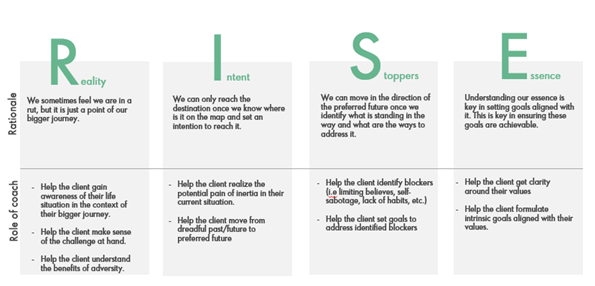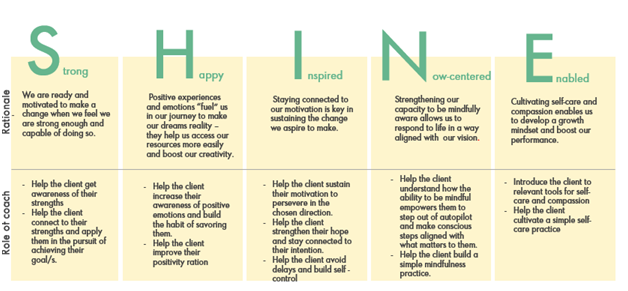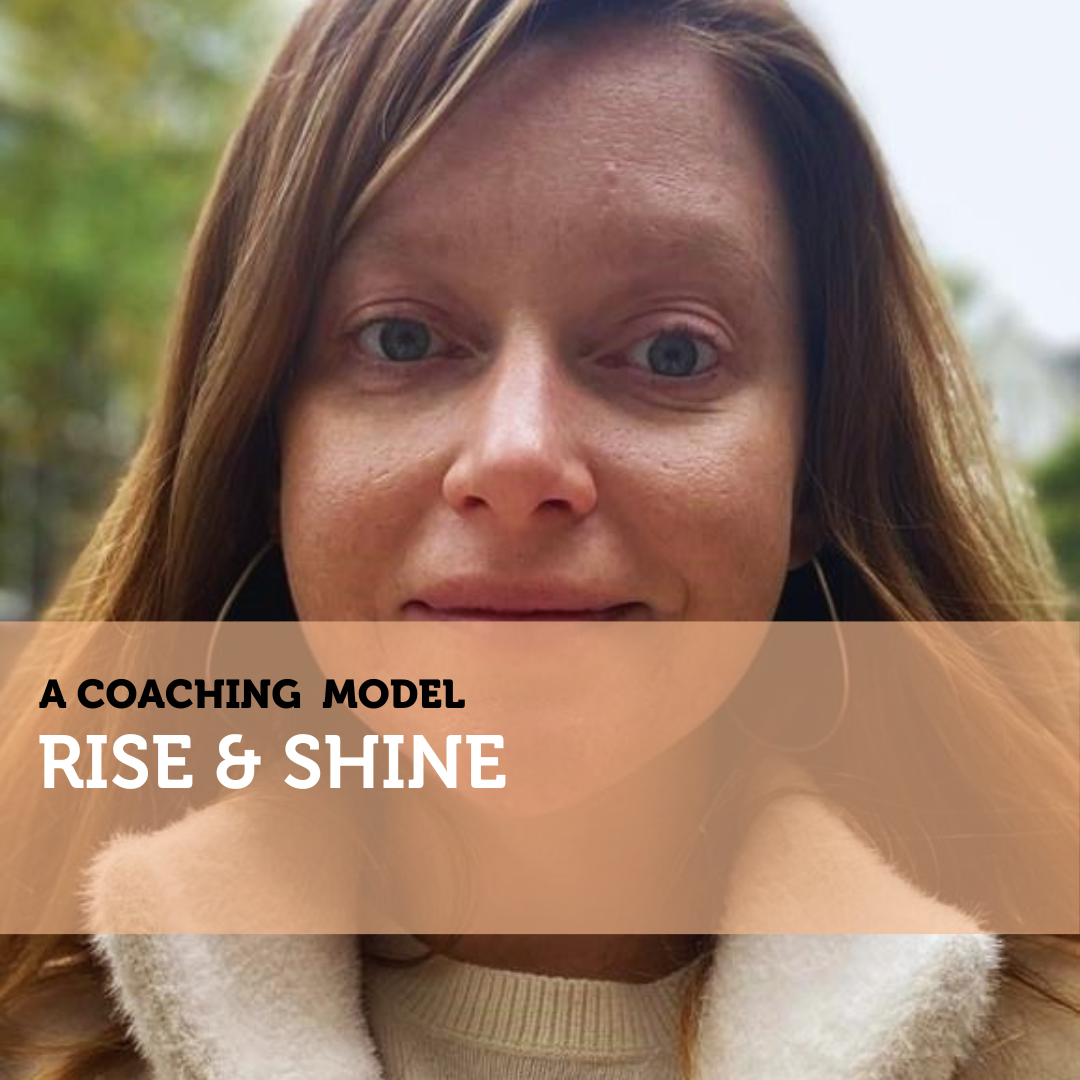A Coaching Model By Ralitsa Antova, Transformational Coach, NETHERLANDS
When Heaven is about to confer a great responsibility on any man, it will exercise his mind with suffering, subject his sinews and bones to hard work, expose his body to hunger, put him to poverty, place obstacles in this path of his deeds, so as to stimulate his mind, harden his nature, and improve wherever he is incompetent. Meng Tzu, China, 3rd Cent. BCE
RISE & SHINE: Coaching Niche
My coaching practice aims to support working professionals (corporate employees or self-employed professionals working in intellectually challenging, fast-paced environments) finding themselves at a low point, which creates a need to revisit and potentially reconstruct their existing life paradigms. The specific issue at hand can be different, i.e.
- Dialing with a disruption (e.g., diagnosed with a chronic health problem, lost their job, faced any personal adversity)
- Feeling “stuck” and unable to progress with a specific goal that one has set for oneself (e.g., grow as a leader, improve as a parent, pursue a healthy lifestyle)
- “Languishing” – not facing a specific problem, but experiencing a lack of zest, vitality, and fulfillment.
Independently of the exact cause, the resulting state of mind is similar – “I`ve lost “the spark” and am not where I am supposed to be”.
Growing From Adversity
My passion is to help people be better than when I met them. Living with a chronical health condition that has forced me to reexamine and make changes in all domains of my life, I`ve experienced firsthand the transformative power of adversity as well as our capacity as humans to thrive and prosper not only despite adversity but because of it. Over time, I`ve developed a strong conviction that we grow out of adversity, and am keen to help my clients develop that shift in their mindset and take responsibility for their lives.
Below I will discuss several theories that support his view and discuss how we as human beings are capable of overcoming adversity and using it as a catalyst for growth and development.
In his book “The Happiness Hypothesis”, Jonathan Haidt introduces an “adversity hypothesis” which states that “people need adversity, setbacks and perhaps even trauma to reach the highest levels of strength, fulfillment, and personal development”. He then discusses the research findings that support this and introduces the evidence-based ways via which people benefit from adversity:
- Going through adversity and raising to challenges that we experience allows us to discover and experience our hidden abilities which eventually change our self-concepts. One of the most commonly experienced lessons of people who endured hardship is that they are much stronger than what they realize which brings appreciation of their strengths and confidence to face future challenges. As Paul said in his letter to Romans, “Suffering produces endurance, endurance produces character and character produces hope”.
- Adversity automatically applies a filter to our relationships, which helps us strengthen the connections with those who stick around and opens people’s hearts to each other. People who experienced loss, trauma, and hardship often report the common realization that treating others with more love is what truly matters.
- Adversity changes priorities and philosophies toward the present and toward others and can serve as a wake-up call and turning point. The reality that people often wake up to is that life is a gift that they might have taken for granted.
Heidt also discusses how adversity “knocks us off the treadmill of life” and forces us to decide whether we want to go back to life as usual or try something else. From that perspective “adversity can be seen as a catalyst for growth, as it forces us to stop speeding along the road of life, allowing us to notice the paths that were branching off along and to think where we really want to end up.”
Adversity has the power to shatter belief systems and rob people of their sense of meaning. In doing so it forces people to put back the pieces together and rebuild themselves in a grander and more coherent way. The resulting inner coherence might not be visible to others, but feels like growth, strength, maturity, and wisdom from the inside.
Nevertheless, there is an important condition that needs to be in place for adversity to enhance growth – the ability to make sense of what has happened and achieve a level of insight that enables them to create a meaningful story out of their experience. And this is one area that my signature offer aims to help with.
Signature Offer
My signature offer enables a personal transformation where the client feels empowered to make a shift from seeing their life situation as a roadblock to a stepping stone to growth, fulfillment, and flourishing. It supports them in formulating a meaningful life story as well as a vision of their preferred future and achieving that vision while at the same time enhancing their well-being and flourishing.
The RISE & SHINE Model
A Client-Centered Model for Achieving Positive Outcomes
The model aims to support the client in understanding and acknowledging their current reality as well as their unique and authentic self (their “Why?”, what do they stand for, e.g. values), shift their focus from dreadful past/current to preferred future and identify& connect to their motivation & resources to feel empowered and move in the direction of their choice. Being underpinned by positive psychology concepts and interventions, it also facilitates a shift towards improved well-being and mental health.
It helps them shift from disempowerment to empowerment, from darkness to light. and where you are where the second one (SHINE) – is about identifying and connecting to your inner spark.
The premise of the model can be summarized as follows:

RISE
The first part of the model (RISE) aims to enable personal exploration and self-awareness, including clarity around their values and specific goals. It is comprised of four elements – Reality, Intent, Stoppers, and Essence, the rationale of each of which is outlined below together with the role of the coach.

SHINE
The second part of the model stems aims to evoke forward action and provide support in walking the steps to achieving the desired change while elevating the well-being of the client. The rationale of each of its five elements (Strong, Happy, Inspired, Now Centered, Enabled) as well as the role of the coach is summarized below:

Underlying Theories
The Positive Psychology theories and concepts below are foundational to the development of the model and many of the tools applied during the various elements are centered in them.
- Flourishing (Martin Seligman)
- Positive Emotions (Barbara Fredrickson)
- Goal-focused coaching (Anthony Grant)
- Self-determination theory (Richard Ryan and Edward Deci)
- ACT (Russel Harris)
- Strengths-based coaching (Ryan Niemiec)
- Mindfulness (Jon Kabat-Zinn)
Learn How to Create Your Own Coaching Model
Your Coaching Model reflects your values,
philosophies, and beliefs and must communicate who you will coach
and the problems you will solve. Read more about creating your coaching model
References
Coaching A to Z: The Extraordinary Use of Ordinary Words (H. Moon, 2022)
Flourish: A visionary new understanding of happiness and well-being (M. Seligman, 2011)
Positivity: Groundbreaking Research Reveals How to Embrace the Hidden Strength of Positive Emotions, Overcome Negativity, and Thrive (B. Fredericson, 2009)
Mindset: The New Psychology of Success (C. Dweck, 2006)
Grant, A. M. An integrated model of goal-focused coaching (2011)
Self-Determination Theory: Basic Psychological Needs in Motivation, Development, and Wellness (Ryan and Deci, 2017)
The Happiness Trap: How to Stop Struggling and Start Living: A Guide to ACT (R. Harris, 2007)
Character Strengths Interventions: A Field Guide for Practitioners (R. Niemiec, 2018)
Full Catastrophe Living: Using the Wisdom of Your Body and Mind to Face Stress, Pain, and Illness (J. Kabat-Zin, 1990)
The Happiness Hypothesis (J. Heidt, 2006)
